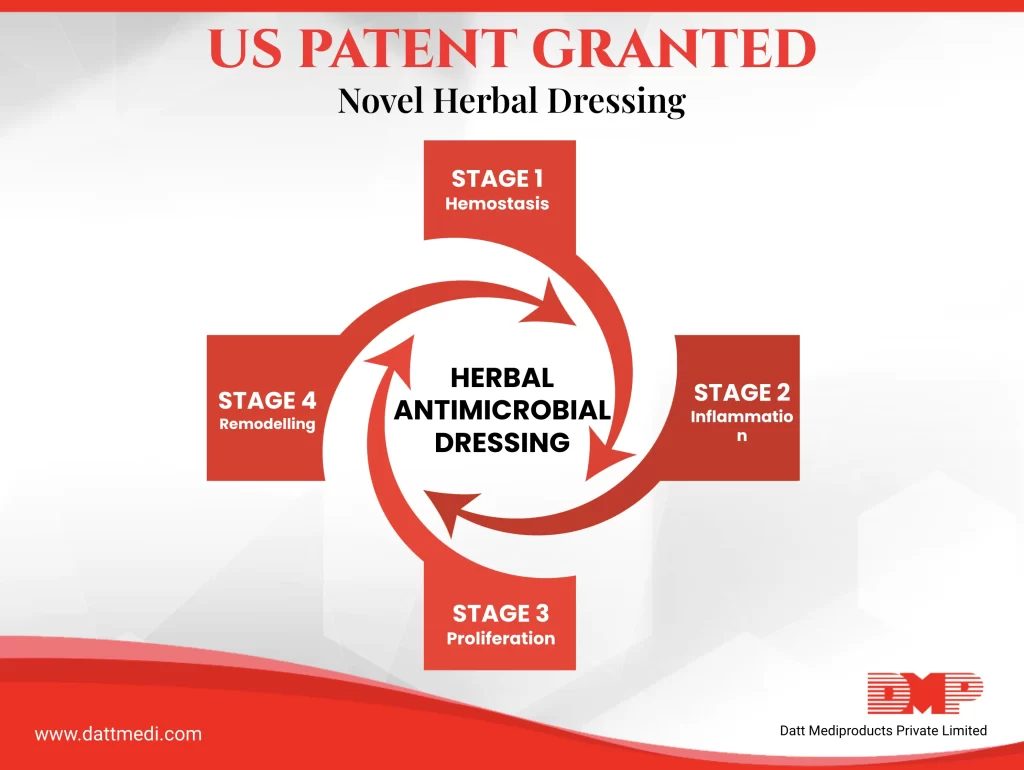
Patent No.: US 10, 076, 552 B2
Date of the Patent Granted: Sep. 18, 2018
Title of the Patent: MULTIFUNCTIONAL FORMULATION COMPRISED OF NATURAL INGREDIENTS AND METHOD OF PREPARATION MANUFACTURING THEREOF
What is Wound Healing & need of the Invention:
Wound Healing is a complex process in which the injured tissue is repaired & regenerated and new tissues are formed. The whole process involves three different phases: inflammation, proliferative and remodeling. Each of these phases is controlled and regulated by biologically active substances called growth factors.
These growth factors are hormone-like molecules that interact with specific cell surface receptors to control the process of tissue repair. The research shows that re-epithelialization is enhanced by the presence of occlusive wound dressings which maintain a moisture barrier.
There are different treatment modalities available for the treatment of wounds and ulcers ranging from antibiotics, occlusive layers, bandages, poultices, mechanical devices that reduce evaporation of water and many others.
The major drawback of these treatment methods is that they enhance wound healing by supporting the body mechanisms to heal the wound. If the patient will have compromised immunity or other body functions that may not work optimally, wound healing will not take place or will be delayed. This may limit the mobility of the patient and lower the quality of life.
There is a need of the treatment method which could actively regenerate the skin, dermis and epidermis. We @ Datt Mediproducts have developed an innovative herbal based antimicrobial dressing which reduce the microflora in wounds and actively promotes healing by stimulating stem cells that are present even in deep wounds and enhance the migration of fibroblast and keratinocytes and secretion of growth factors.
ABOUT THE INVENTION:
The invention involves polymer chemistry and herbal formulation preparation for the treatment of compromised tissues like infected wounds, burn wounds and ulcers in both humans and animals. It is used as a topical device for a range of indications including anti – cancer transdermal patch for melanoma therapy, superbugs infected tropical wounds and multiple sclerosis also.
The invention is composed of a water solubilized nano-sized formulation of a non-aqueous extract of phyto-pharmaceuticals, animal or synthetic biocompatible gel or on matrix coated or both.
SUMMARY OF THE INVENTION:
The present invention provides a wound healing matrix comprising of a variety of natural ingredients, all working together in a synergistic way to promote wound healing by stimulating the stem cells. Stem cells have a great potential of cell division and are ultimately responsible for the homeostasis of steady state tissues.
Stem cells are normally slow cycling. However, there proliferation can be stimulated by certain growth factors. For example, cytokines such as Tumor Necrosis Factor (TNF), Epidermal Growth Factor (EGF), Transforming Growth Factor (TGF) and Interleukin-1 (IL-1) are believed to be useful.
The present invention consists of different herbs and synthetic biopolymers which are helpful in relieving pain, providing a soothing effect, and healing the wounds upon repeated use by providing a moist healing environment and stimulating the stem cells to regenerate the lost tissues.
The transdermal patch formulated with phytopharmaceutical preparation is intended for transdermal delivery system preferably for cancer therapy either individually or the combination.
Advantages of the Invention:
- It provides a multi-purpose wound healing matrix with a bandage for compromised tissues viz. skin having wounds or melanoma.
- Enhanced bioavailability of its individual components, working together in a synergistic way.
- Another promising advantage of this phytopharmaceutical invention is that it displays minimal side effects in clinical applications of the drug.
- Since the components in the formulation are from herbal / natural resources, it is very safe and eco – friendly and does not produce any adverse effect on the skin.
Following are the broad range of applications:
- Anti-microbial
- Anti-inflammatory
- Analgesic
- Antioxidant
- Wound healing
- Radiation poisoning
- Modulates immunity
- Biocompatible
- Haemostatic
- Nano based technology for drug releasing
- Anti-cancer properties
- Multiple sclerosis
Follow us @Datt Mediproducts to know more about such innovative patented.



